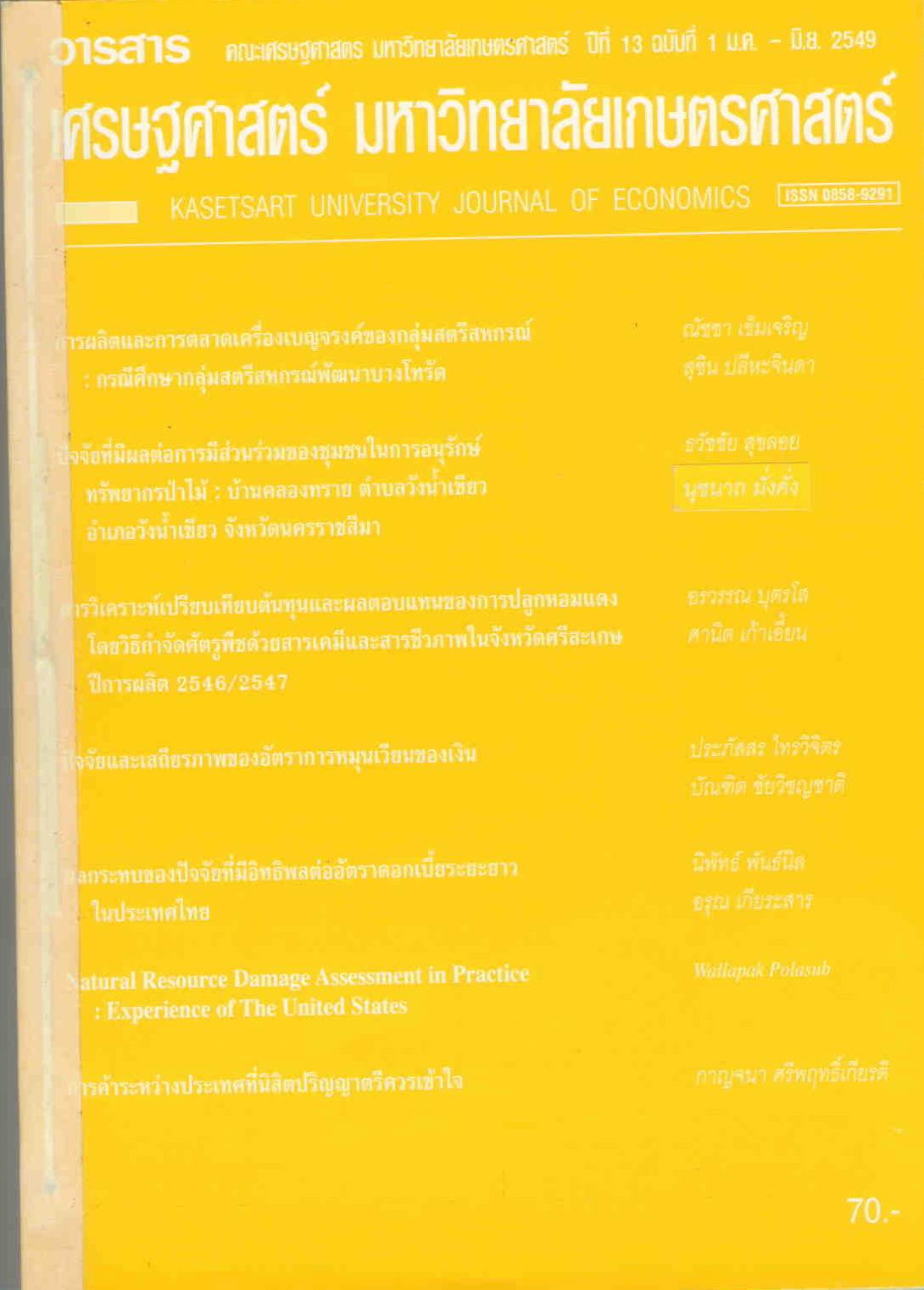การวิเคราะห์เปรียบเทียบต้นทุนและผลตอบแทนของการปลูกหอมแดง โดยวิธีกำจัดศัตรูพืชด้วยสารเคมีและสารชีวภาพในจังหวัดศรีสะเกษ ปีการผลิต 2546/2547
Main Article Content
Abstract
บทคัดย่อ
การศึกษาครั้งนี้ทำการเปรียบเทียบต้นทุนและผลตอบแทน รวมทั้งศึกษาสมการต้นทุนในการปลูกหอมแดง ระหว่างวิธี ป้องกัน/กำจัดศัตรูพืชด้วยสารเคมี และวิธีป้องกัน/กำจัดศัตรูพืชด้วยสารชีวภาพ โดยใช้ข้อมูลปีการผลิต 2546/2547 ที่ได้จากการสัมภาษณ์เกษตรกรผู้ปลูกหอมแดงในจังหวัดศรีสะเกษจำนวน 90 ราย เป็นกลุ่มเกษตรกรที่ป้องกัน/กำจัดศัตรูพืชด้วยสารเคมี 45 ราย และสารชีวภาพ 45 ราย ผลการศึกษาสมการอุปทานการผลิตหอมแดงของเกษตรกรกลุ่มที่ใช้สารเคมีและกลุ่มที่ใช้ลารชีวภาพในการป้องกัน/ กำจัดศัตรูพืช พบว่า เกษตรกรจะเริ่มทำการผลิตเมื่อได้รับราคาต่ำสุดกิโลกรัมละ 3.89 และ 3.46 บาท ตามลำดับ โดยเกษตรกรกลุ่มที่ใช้สารเคมีในการป้องกัน/กำจัดศัตรูพืช มีต้นทุนทั้งหมดเฉลี่ยต่อไร่ 18,507.16 บาท ได้ผลผลิตต่อไร่ 2,153.06 กิโลกรัม ขายได้ กิโลกรัมละ 7.42 บาท ดังนั้นเกษตรกรขาดทุนสุทธิไร่ละ 2,526.55 บาท ส่วนกลุ่มเกษตรกรที่ป้องกัน/กำจัดศัตรูพืชโดยการใช้สารชีวภาพ มีต้นทุนทั้งหมดเฉลี่ยต่อไร่ 17,176.54 บาท ได้ผลผลิตต่อไร่ 2,409.22 กิโลกรัม ขายได้กิโลกรัมละ 6.95 บาท ดังนั้นเกษตรกรขาดทุนสุทธิไร่ละ 434.71 บาท สาเหตุของการขาดทุนเนื่องจากเกษตรกรขาดระบบการจัดการด้านการผลิตที่ดี มีการใช้แรงงานคนในครัวเรือนมาก ทำให้มีต้นทุนที่ไม่เป็นตัวเงินสูง แต่เมื่อคิดเฉพาะรายรับเหนือต้นทุนที่เป็นเงินลด เกษตรกรทั้งสองกลุ่มมีรายรับจากการปลูกหอมแดงไร่ละ 7,565.50 และ 4,413.16 บาท ตามลำดับ
คำสำคัญ : ต้นทุนผลตอบแทน, หอมแดง, ศรีสะเกษ
ABSTRACT
This research were estimate cost function and supply function of shallot production by using chemical and biopesticides and compare return of shallot production by using chemical and bio-pesticides. The data used in this study were obtained from interviewing of 90 farmers who grow' shallot in Si Sa Ket Province during 2003/2004 crop year. They were divided into two groups. Each group was composed of 45 farmers. The result of supply function of the shallot production among the farmers who used chemical and bio-pesticides showed that the farmers started shallot production when the minimum price reached 3.89 and 3.46 baht per kilogram respectively. The average total cost of shallot production and return per rai of the farmers who used chemicd pesticides was 18,507.16 baht. The obtained product per rai was 2,153.06 kilograms and was sold at the rate of 7.42 baht per kilogram. So, the farmers incurred a loss of 2,526.55 baht. Thse average total cost of shallot production and return per rai of the farmers who used bio-pesticides was 17,176.54 baht. The obtained product per rai was 2,409.22 kilograms and was sold at the rate of 6.95 baht per kilogram. Thus, the farmers incurred a loss of 434.71 baht. The loss of the two groups was due to poor farm management. In other word, they used too much family labor which increased the implicit cost. However, if only the return over cash cost was considered, both groups would obtain the return over cash cost of 7,565.50 and 4,413.16 baht respectively.
Key word : Cost and Return, Shallot, Si Sa Ket
Article Details
The paper is published under CC BY-NC-ND, in which the article is freely downloaded and shared in its original form non-commercially and its citation details are identified.


